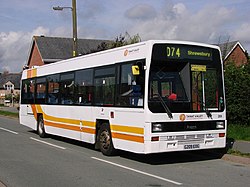| Revision as of 21:16, 24 November 2009 edit92.236.31.78 (talk)No edit summary← Previous edit | Revision as of 02:09, 25 November 2009 edit undo158.132.167.192 (talk) →Preservation: rm "sadly"Next edit → | ||
| Line 21: | Line 21: | ||
| Several Mk1 and Mk2 Lynxes have now gone into preservation, with some requiring extensive rebuilds to bring them back to original condition due to body corrosion, as well as reversing modifications made by companies during their history. One such example is the removal of all of the patterned body skirts, combined with the replacement of the square wheel arches with non-patterned round ones. Both of these modifications were made to make it easier to replace such parts in the event of an accident. | Several Mk1 and Mk2 Lynxes have now gone into preservation, with some requiring extensive rebuilds to bring them back to original condition due to body corrosion, as well as reversing modifications made by companies during their history. One such example is the removal of all of the patterned body skirts, combined with the replacement of the square wheel arches with non-patterned round ones. Both of these modifications were made to make it easier to replace such parts in the event of an accident. | ||
| A recent addition to the growing number of Lynxes in preservation is Lothian Lynx H188 OSG. This Lynx Mk2 is now the last of only 12 lynxes built by Leyland to feature duel doors. |
A recent addition to the growing number of Lynxes in preservation is Lothian Lynx H188 OSG. This Lynx Mk2 is now the last of only 12 lynxes built by Leyland to feature duel doors. The bus had its second door removed by Brylaine Travel in 2000. Now that the bus has entered preservation it will have its second door re-installed as part of the vehicle's restoration. | ||
| {{commons cat}} | {{commons cat}} | ||
Revision as of 02:09, 25 November 2009
| This article does not cite any sources. Please help improve this article by adding citations to reliable sources. Unsourced material may be challenged and removed. Find sources: "Leyland Lynx" – news · newspapers · books · scholar · JSTOR (November 2008) (Learn how and when to remove this message) |



The Leyland Lynx is a single-decker bus built by Leyland between 1984 and 1992. It was designed to replace the aging Leyland National.
The type saw service all over the UK, with the largest fleet being based in the West Midlands, owned by West Midlands Travel (now National Express West Midlands), however the final three were withdrawn from normal passenger use in March 2009, with 10 now remaining in the driver training fleet.
Production vehicles began to enter service in 1986. From 1990 to 1992 the updated Lynx II version was produced. It could be recognised easily by its protruding front dash/grille panel, which on the original design was flat. The last two Lynxes entered service with Halton Transport (Widnes) in 1992 and 6 examples are still in in use.
Although the large majority of Lynxes carried the Leyland body, seven underframes were bodied by Alexander with N-type bodywork for Citybus (Belfast), including the first prototype. A small number of other underframes for export were bodied by other coachbuilders, including an Alexander PS type for Singapore Bus Service and 2 PMC Metro 90 (Galvastress MKV) bodied ones for Sydney, Australia.
Following the takeover of Leyland by Volvo, the Lynx was superseded by the Volvo B10B. Total production of Lynxes was approximately 1060 vehicles, including six prototypes (one of which was not bodied) and several development vehicles. About 140 of the total were Lynx II.
The last ever Leyland Lynx to roll off the production line is owned by Halton Transport in Widnes. It is registered K853 MTJ, 57. Halton Transport still operates a small number of Lynx's although all used on school contracts.
Preservation
Several Mk1 and Mk2 Lynxes have now gone into preservation, with some requiring extensive rebuilds to bring them back to original condition due to body corrosion, as well as reversing modifications made by companies during their history. One such example is the removal of all of the patterned body skirts, combined with the replacement of the square wheel arches with non-patterned round ones. Both of these modifications were made to make it easier to replace such parts in the event of an accident.
A recent addition to the growing number of Lynxes in preservation is Lothian Lynx H188 OSG. This Lynx Mk2 is now the last of only 12 lynxes built by Leyland to feature duel doors. The bus had its second door removed by Brylaine Travel in 2000. Now that the bus has entered preservation it will have its second door re-installed as part of the vehicle's restoration.
| Leyland buses | |
|---|---|
| Single-deck | |
| Double-deck | |
| Articulated | |
| List of Leyland buses | |
This bus-related article is a stub. You can help Misplaced Pages by expanding it. |